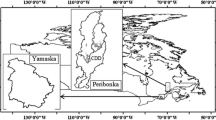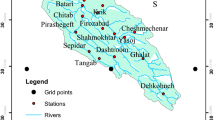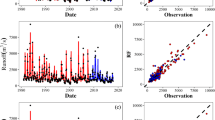Abstract
Meteorological Ensemble Streamflow Prediction (ESP), which uses Ensemble Weather forecasts (EWFs) to drive hydrological models, is a useful methodology for extending forecast periods and to provide valuable uncertainty information to improve the operation of future water resources. However, raw EWFs are usually biased and under-dispersive and so cannot be directly used in ESP, leading to the development of several post-processing methods. The performance of these methods needs to be evaluated/compared in building ESP based on deterministic and probabilistic criteria. In addition, likely influencing factors also need to be identified. This study evaluated the performance of four state-of-the-art methods: the Generator-based Post-Processing (GPP) method, Extended Logistic Regression (ExLR), Bayesian Model Averaging (BMA) and Affine Kernel Dressing (AKD), using a simple bias correction (BC) method as a benchmark. The evaluation was carried out over four watersheds with different basin areas in the humid region of central-south China based on the weather reforecasts from the Global Ensemble Forecasting System (GEFS). The results show that the performance of the post-processing methods varies with the forecast variable (precipitation, or air temperature or streamflow), but all of them outperform the BC and GEFS. For the four post-processing methods, the advantage of the generator-based methods (GPP and ExLR) lies in their probabilistic performance, which outperforms the distribution-based methods (BMA and AKD) by about 10% in precipitation forecasts and about 20% in streamflow forecasts, while the distribution-based methods (BMA and AKD) are better at their deterministic performance for precipitation forecasts, with a benefit of about 15%. Meanwhile, the post-processing methods generally perform better for precipitation and streamflow forecasts, but worse for air temperature forecasts for a bigger basin compared to the distribution-based methods. The results of this study emphasize the importance of considering the uncertainty of post-processing methods in ESP.







Similar content being viewed by others
References
Alfieri L, Pappenberger F, Wetterhall F, Haiden T, Richardson D, Salamon P (2014) Evaluation of ensemble streamflow predictions in Europe. J Hydrol 517:913–922. https://doi.org/10.1016/j.jhydrol.2014.06.035
Bröcker J, Smith LA (2008) From ensemble forecasts to predictive distribution functions. Tellus A 60:663–678. https://doi.org/10.1111/j.1600-0870.2008.00333.x
Baran S, Nemoda D (2016) Censored and shifted gamma distribution based EMOS model for probabilistic quantitative precipitation forecasting. Environmetrics 27:280–292. https://doi.org/10.1002/env.2391
Brown JD, Demargne J, Seo D-J, Liu Y (2010) The Ensemble Verification System (EVS): A software tool for verifying ensemble forecasts of hydrometeorological and hydrologic variables at discrete locations. Environ Model Softw 25:854–872. https://doi.org/10.1016/j.envsoft.2010.01.009
Chen J, Brissette FP, Li Z (2014) Postprocessing of ensemble weather forecasts using a stochastic weather generator. Mon Weather Rev 142:1106–1124. https://doi.org/10.1175/MWR-D-13-00180.1
Cloke HL, Pappenberger F (2009) Ensemble flood forecasting: a review. J Hydrol 375:613–626. https://doi.org/10.1016/j.jhydrol.2009.06.005
Hagedorn R, Hamill TM, Whitaker JS (2008) Probabilistic forecast calibration using ecmwf and GFS ensemble reforecasts Part I: two-meter temperatures. Mon Weather Rev 136:2608–2619. https://doi.org/10.1175/2007MWR2410.1
Hamill TM, Hagedorn R, Whitaker JS (2008) Probabilistic forecast calibration using ECMWF and GFS ensemble reforecasts. Part II: precipitation. Mon Weather Rev 136:2620–2632. https://doi.org/10.1175/2007MWR2411.1
Kavetski D, Kuczera G, Franks SW (2006a) Bayesian analysis of input uncertainty in hydrological modeling: 1. theory. Water Resour Res 42:W03407. https://doi.org/10.1029/2005WR004368
Kavetski D, Kuczera G, Franks SW (2006b) Bayesian analysis of input uncertainty in hydrological modeling: 2. application. Water Resour Res 42:W03408. https://doi.org/10.1029/2005WR004376
Liu X, Coulibaly P (2011) Downscaling ensemble weather predictions for improved week-2 hydrologic forecasting. J Hydrometeorol 12:1564–1580. https://doi.org/10.1175/2011JHM1366.1
Raftery AE, Gneiting T, Balabdaoui F, Polakowski M (2005) Using Bayesian model averaging to calibrate forecast ensembles. Mon Weather Rev 133:1155–1174. https://doi.org/10.1175/MWR2906.1
Roulin E (2007) Skill and relative economic value of medium-range hydrological ensemble predictions. Hydrol Earth Syst Sci 11:725–737. https://doi.org/10.5194/hess-11-725-2007
Roulin E, Vannitsem S (2012) Postprocessing of ensemble precipitation predictions with extended logistic regression based on hindcasts. Mon Weather Rev 140:874–888. https://doi.org/10.1175/MWR-D-11-00062.1
Scheuerer M, Hamill TM (2015) Statistical postprocessing of ensemble precipitation forecasts by fitting censored, shifted gamma distributions. Mon Weather Rev 143:4578–4596. https://doi.org/10.1175/MWR-D-15-0061.1
Schmeits MJ, Kok KJ (2010) A comparison between raw ensemble output, (modified) Bayesian model averaging, and extended logistic regression using ECMWF ensemble precipitation reforecasts. Mon Weather Rev 138:4199–4211. https://doi.org/10.1175/2010MWR3285.1
Shukla S, Voisin N, Lettenmaier DP (2012) Value of medium range weather forecasts in the improvement of seasonal hydrologic prediction skill. Hydrol Earth Syst Sci 16:2825–2838. https://doi.org/10.5194/hess-16-2825-2012
Siddique R, Mejia A (2017) Ensemble streamflow forecasting across the U.S. Mid-Atlantic region with a distributed hydrological model forced by GEFS reforecasts. J Hydrometeorol 18:1905–1928. https://doi.org/10.1175/JHM-D-16-0243.1
Sloughter JML, Raftery AE, Gneiting T, Fraley C (2007) Probabilistic quantitative precipitation forecasting using Bayesian model averaging. Mon Weather Rev 135:3209–3220. https://doi.org/10.1175/MWR3441.1
Vannitsem SP, Hagedorn R (2011) Ensemble forecast post-processing over Belgium: comparison of deterministic-like and ensemble regression methods. Meteorol Appl 18:94–104. https://doi.org/10.1002/met.217
Vetter T, Reinhardt J, Flörke M, van Griensven A, Hattermann F, Huang S et al (2016) Evaluation of sources of uncertainty in projected hydrological changes under climate change in 12 large-scale river basins. Clim Chang 141:419–433. https://doi.org/10.1007/s10584-016-1794-y
Verkade JS, Brown JD, Reggiani P, Weerts AH (2013) Post-processing ECMWF precipitation and temperature ensemble reforecasts for operational hydrologic forecasting at various spatial scales. J Hydrol 501:73–91. https://doi.org/10.1016/j.jhydrol.2013.07.039
Wilks DS (2006) Comparison of ensemble-MOS methods in the Lorenz '96 setting. Meteorol Appl 13:243–214. https://doi.org/10.1017/S1350482706002192
Wilks DS, Hamill TM (2007) Comparison of ensemble-MOS methods using GFS reforecasts. Mon Weather Rev 135:2379–2390. https://doi.org/10.1175/MWR3402.1
Wilks DS (2009) Extending logistic regression to provide full-probability-distribution MOS forecasts. Meteorol Appl 16:361–368. https://doi.org/10.1002/met.134
Xu Y-P, Tung Y-K (2007) Decision making in water management under uncertainty. Water Resour Manag 22:535–550. https://doi.org/10.1007/s11269-007-9176-x
Acknowledgements
This work was partially supported by the National Natural Science Foundation of China (Grant No. 51779176, 51539009), the Overseas Expertise Introduction Project for Discipline Innovation (111 Project) funded by the Ministry of Education and State Administration of Foreign Experts Affairs P.R. China (Grant No. B18037), the Thousand Youth Talents Plan from the Organization Department of the CCP Central Committee (Wuhan University, China), and the Research Council of Norway (FRINATEK Project 274310). The authors would like to acknowledge the National Oceanic and Atmospheric Administration (NOAA), Boulder, Colorado, USA for providing GEFS ensemble precipitation and air temperature reforecasts. The authors wish to thank the China Meteorological Data Sharing Service System and the Hydrology and Water Resources Bureau of Hunan Province, China for providing the daily meteorological and hydrological data in the Xiangjiang basin.
Author information
Authors and Affiliations
Corresponding author
Ethics declarations
Conflict of Interest
The authors declare that they have no conflict of interest with the information presented in this study.
Additional information
Publisher’s Note
Springer Nature remains neutral with regard to jurisdictional claims in published maps and institutional affiliations.
Rights and permissions
About this article
Cite this article
Li, XQ., Chen, J., Xu, CY. et al. Performance of Post-Processed Methods in Hydrological Predictions Evaluated by Deterministic and Probabilistic Criteria. Water Resour Manage 33, 3289–3302 (2019). https://doi.org/10.1007/s11269-019-02302-y
Received:
Accepted:
Published:
Issue Date:
DOI: https://doi.org/10.1007/s11269-019-02302-y




